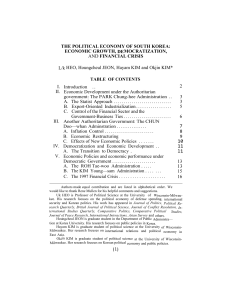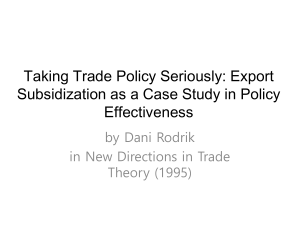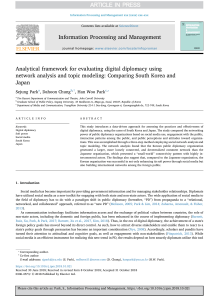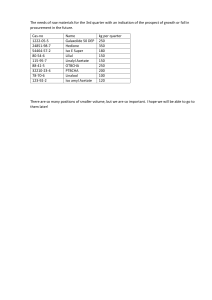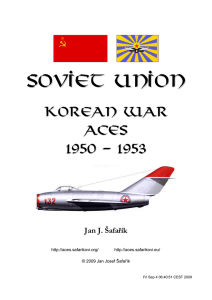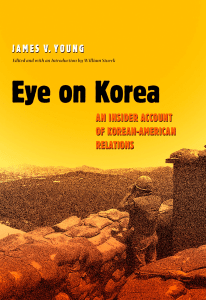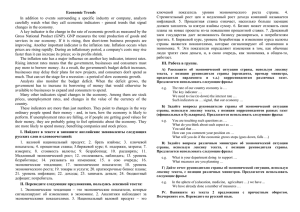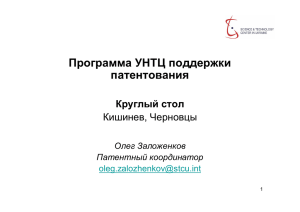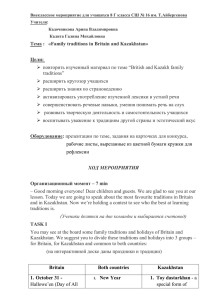The financial system of South Korea
advertisement
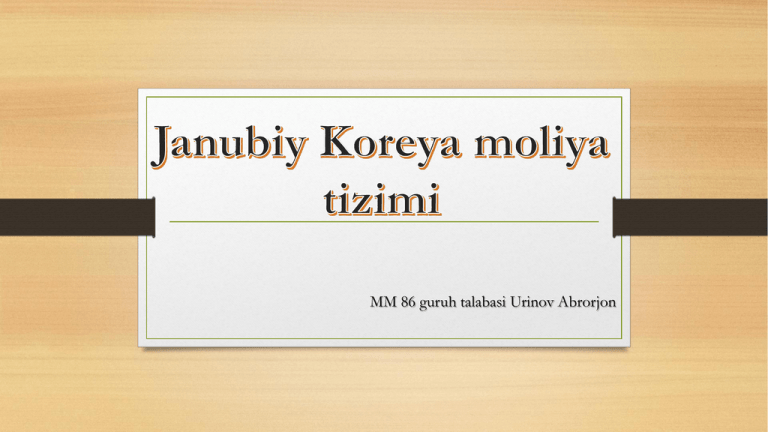
ММ 86 guruh talabasi Urinov Abrorjon South Korea Tashkil etilgan: Hududi: Aholisi: Rasmiy tili: Etnik guruhi Poytaxt: Boshqaruv shakli: Konstitutsiyasi: Prezident: Bosh vazir: Qonun chiq. hokimiyat: YaIM: Hajmi: Avgust 15, 1948 100,210 km2 (109th) 51,302,044 kishi (2014) Koreys tili Asosan Korealiklar Seoul Unitar presidentar kostitutsional respublika October 29, 1987 Park Guen-hye Lee Wan-koo National Assembly 1,449 trillion dollar (2014) 487 kishi /1km2 Prezident: Park Guen-hye Bosh vazir: Lee Wan-koo Park Guen-hye Janubiy Koreyaning o’n birinchi va birinchi ayol prezidentidir. Janubiy Koreyaning rasmiy nomi Koreya Respublikasidir. Bu mamlakat Osiyo qit’asining sharqiy qismida, Koreya yarim orolida joylashgan bo’lib shimoldan KXDR davlati bilan shegaradosh qolgan qismlari esa suv bilan o’ralgan. “Koreya” so’zining kelib chiqishi uzoq o’tmishga ya’ni Gogryo qirolligi (Kingdom of Goryeo) ga borib taqaladi. Aholisining deyarli yarmi Janubiy Koreyaning poytaxti Seul shahri va uning atroflarida istiqomat qilishadi 1962 yildan 1994 yilgacha Janubiy Koreyaning iqtisodiyoti yiliga o’rtacha 10 foizdan o’sib bordi. Hozirgi kunga kelib ushbu mamlakat import bo’yicha yettinchi, eksport bo’yicha esa sakkizinchi o’rinda turadi. Bundan tashqari Koreya G-20 a’zosi Metallurgiya, mashinasozlik, neftni qayta ishlovchi va kimyo sanoati, to`qimachilik va oziq-ovqat sanoati tarmoqlari rivojlangan. Qishloq xo’jaligining asosiy tarmog’i dehqonchilik. Don (sholi, g’alla, arpa), dukkaklilar yetishtirish ustun turadi. Paxta, tamaki, kanop kabi texnika ekinlari yetishtiriladi. Bog`dorchilik, sabzavotchilik tarmoqlari bor. Temir yo`llarning uzunligi 6,24ming km, shundan 525km elektrlashtirilgan. Avtomobil yo’llari 87534km. Dengiz portlari: Pusan, Ulsan, Inchxon. Eksport mahsulotlari: yengil sanoat mahsulotlari, avtomobil, kema, po’lat, elektronika mahsulotlari, mashina va jihozlar, baliq. Asosiy tashqi savdo hamkorlari: Yaponiya, AQSh, Xitoy, Gonkong, Tayvan, Avstraliya, Saudiya Arabistoni. Pul birligi - Janubiy Koreya vonasi. Janubiy koreya iqtisodiy erkinligi darajasi: 71.5 bo’lib, 2015-yil jahon miqiyosida 29-o’rinda turadi. Ko’rsatkichlari jahon va osiyo o’rtacha ko’rsatkichlaridan ham yuqori. Makroiqtisodiy ko’rsatkichlar YaIM: 1.304 trillion dollar (2014) YaIM: 0.3% 2015-yil 1-chorak holatiga YaIM aholi jon boshiga: 23,892 dollar YaImning sohalar bo’yicha ulushi: Qishloq xo’jaligi Sanoat – Xizmat ko’rsatish – 2.6 % 39.2 % 58.2 % Inflatsiya darajasi: 1.1 % (2014 yanvar holatiga) Eksport hajmi: 557.3 trillion dollar c Asosiy eksport hamkorari: Xitoy – 24.4 %, AQSH – 10.1 %, Yaponiya – 7.1 % Import hajmi: 516.6 trillion dollar (7th; 2014) Asosiy import hamkorlari: Xitoy – 16.5 % , Yaponiya – 13.0 % , AQSH – 8.5 % , Saudiya Arabistoni – 7.1 % , Avstraliya – 5.0 % Mamlakat tashqi qarzi: 430.9 trillion dollar Janubiy Koreya Moliya tizimi ikkiga bo’linadi: 1. Davlat moliyasi 2. Moliya institutlari moliyasi Davlat moliyasi o’z navbatida quyidagilarga bo’linadi: 1. Milliy moliya 2. Mahalliy moliya Milliy moliya quyidagilarga bo’linadi: 1. Davlat bujeti; 2. 21ta maxsus budjetlar; 3. 35 ta davlat tashkilotlari fondi Mahalliy moliya esa mahalliy budjetlar, 6 ta kata shaharlar budjeti, 9 ta provinsiyalar budjetiga bo’linadi. Moliya yili har yilning1-yanvarda boshlanib 31-dekabrida tugaydi. Barcha moliyaviy masalalar National Finance Act qonun hujjati tomonidan tartibga solinadi. Janubiy Koreya yalpi ichki mahsuloti Janubiy Koreya davlat qarzi YaIM aholi jon boshiga 2014-yil Budjeti Budjetga ta’minotni hisobga olmaganda (A) Umumiy Ishsizlik bo’yicha Ta’lim Madaniyat, Sport, Turizm Atrof-muhit R&D Sanoat va energetika SOC Qishloq xo’jaligi Oziq-ovqat va baliqchilik Milliy mudofaa Diplomatiya va reyunifikatsiya Ijtimoiy tartib Mahalliy 2015-yil Budjeti Ko’zda tutilgani (B) Qabul qilingan budjet (C) FARQ (C – B) 2014 dan (C – A) 2014 dan % 355.8 106.4 50.7 (9.8) 5.4 6.5 17.8 15.4 23.7 376.0 115.5 53.0 (13.5) 6.0 6.7 18.8 16.5 24.4 375.4 115.7 52.9 (13.5) 6.1 6.8 18.9 16.4 24.8 -0.6 0.2 -0.1 (-0.004) 0.1 0.1 0.1 -0.03 0.4 19.6 9.2 2.2 (3.7) 0.7 0.4 1.1 1.0 1.1 5.5 8.7 4.4 (37.4) 13.0 5.5 6.4 6.8 4.7 18.7 19.3 19.3 0.01 0.6 3.1 35.7 4.2 15.8 57.2 (21.6) 37.6 4.5 16.9 59.2 (24.5) 37.5 4.5 16.9 58.0 (23.1) -0.1 -0.01 0.04 -1.2 (-1.4) 1.8 0.3 1.2 0.8 (1.6) 4.9 6.7 7.3 1.4 (7.4) Janubiy Koreya davlat budjeti 2014 May 2015 Eng yuqori Eng past Davlat budjeti -1.50 -1.30 3.47 -4.10 % YaIM [+] YaIM ga nisbatan davlat qarzi 33.80 34.80 34.80 7.99 % [+] Budjet qiymati -8524.00 5829.00 42914.00 -28619.00 Milliard Koreya voni [+] Davlat xarajati 52179.20 52066.50 52179.20 4673.10 [+] Kredit darajasi 80.74 Milliard Koreya voni [+] Koreya bank tizimi ikkiga bo’linadi: 1. Markaziy bank (Bank of Korea) 2. Bank institutlari Bank institutlari esa o’z navbatida tijorat va maxsus banklarga bo’linadi Koreya markaziy banki 1950 yil 12 iyunda tashkil etilgan. Ushbu bankning vazifalari: pul emissiya qiladi, kredit va monetar siyosati olob boradi, banklar nazoratini olib boradi va boshqalar. Hozirgi kunda Janubiy Koreyada oltita milliy tijorat banklari (davlat banklari), oltita mahalliy banklar va 39 ta chet el banklari mavjuddir. Tijorat banklari filiallarining umumiy miqdori tazminan 4900 taga yetadi. Maxsus banklarning asosiy maqsadi mamlakat xalq xo’jaligining ma’lum bir sohasini rivojlantirish va moliyalashtirishdir. Janubiy Koreya maxsus banklari quyidagilar: 1. Koreya taraqqiyot banki; 2. Koreya eksport-import banki; 3. Koreya Industrial banki; 4. Milliy qishloq xo’jaligi kooperativ federatsiyasining banki Qo’shilgan qiymat solig’i 10% ni tashkil etadi. Jismoniy shaxslardan olinadigan daromad solig’i maxsimal darajasi 38% ni tashkil etadi. Ijtimoiy sug’urta 18.52%: kompaniyalar uchun 10.23%, ishchilar uchun 8.29% Korporatsiyalardan olinadigan daromad solig’i: Soliq solinadigan bazani 200million won gacha 11% Soliq solinadigan bazani 20trillion won gacha 22% Soliq solinadigan bazani 20 trillion wondan yuqorisiga 24.2% Jismoniy shaxslardan olinadigan daromad solig’i: 12 million (US$10,321) won gacha - 6% 12 milliondan 46 milliongacha (US$10,321) - 15% 46 milliondan 88 milliongacha(US$83,019) - 24% 88 milliondan 300 milliongacha (US$283,019) - 35% 300 milliondan ko’p - 38 % Barcha soliqlar o’rtacha daromadlarning 26.8% iga to’g’ri keladi. South Korea, officially the Republic of Korea, and commonly referred to as Korea, is a sovereign state in East Asia, constituting the southern part of the Korean Peninsula. The name Korea is derived from the Kingdom of Goryeo, also spelled as Koryŏ. It shares land borders with North Korea to the north, and oversea borders with Japan to the east and China to the west. Roughly half of the country's 50 million people reside in the metropolitan area surrounding its capital, the Seoul Capital Area, which is the second largest in the world with over 25 million residents. Between 1962 and 1994, South Korea's tiger economy soared at an average of 10% annually, fueled by annual export growth of 20%, in a period called the Miracle on the Han River that rapidly and successfully transformed it into a high-income advanced economy and the world's 11th largest economy by 1995. Today, South Korea is the world's seventh largest importer and eighth largest exporter, ranking as the eighth largest country in international trade, a member of the G-20 South Korea is East Asia's highest ranked developed country in the Human Development Index. Its citizens enjoy a very high standard of living, having Asia's highest median per-capita income and average wage with the world's 8th highest household income. Globally, it ranks among the highest in education, quality of healthcare and ease of doing business. It benefits from a highly skilled workforce, leading OECD countries in student skills with the highest percentage of youths holding a tertiary education degree. Ranked as the world's most innovative country in the Bloomberg Innovation Index, it is the world's most research and development intensive country, driven by high-tech companies such as Samsung, Hyundai-Kia and LG. A world leading information society, South Korea has the world's fastest Internet connection speed, ranking first in e-Government. South Korea has 20 national parks and popular nature places like the Boseong Tea Fields, Suncheon Bay Ecological Park, and the first national park of Jirisan. South Korea is noted for its population density, which is 487 per square kilometer, more than 10 times the global average. Most South Koreans live in urban areas, because of rapid migration from the countryside during the country's quick economic expansion in the 1970s, 1980s and 1990s. The capital city of Seoul is also the country's largest city and chief industrial center. According to the 2005 census, Seoul had a population of 9.8 million inhabitants. The Seoul National Capital Area has 24.5 million inhabitants (about half of South Korea's entire population) making it the world's second largest metropolitan area and easily the most densely populated city in the OECD. Other major cities include Busan (3.5 million), Incheon (2.5 million), Daegu (2.5 million), Daejeon (1.4 million), Gwangju (1.4 million) and Ulsan (1.1 million).[56] The population has also been shaped by international migration. After World War II and the division of the Korean Peninsula, about four million people from North Korea crossed the border to South Korea. This trend of net entry reversed over the next 40 years because of emigration, especially to the United States and Canada. South Korea's total population in 1955 was 21.5 million, and today it is roughly 50,062,000. The National Assembly of South Korea A long history of invasions by neighbors and the unresolved tension with North Korea have prompted South Korea to allocate 2.6% of its GDP and 15% of all government spending to its military (Government share of GDP: 14.967%), while maintaining compulsory conscription for men. Consequently, South Korea has the world's sixth largest number of active troops (650,000 in 2011), the world's secondlargest number of reserve troops (3,200,000 in 2011) and the eleventh largest defense budget. The Republic of Korea, with both regular and reserve military force numbering 3.7 million regular personnel among a total national population of 50 million people, has the second highest number of soldiers per capita in the world, after the Democratic People's Republic of Korea. The South Korean military consists of the Army (ROKA), the Navy (ROKN), the Air Force (ROKAF), and the Marine Corps (ROKMC), and reserve forces. Many of these forces are concentrated near the Korean Demilitarized Zone. All South Korean males are constitutionally required to serve in the military, typically 21 months. A long history of invasions by neighbors and the unresolved tension with North Korea have prompted South Korea to allocate 2.6% of its GDP and 15% of all government spending to its military , while maintaining compulsory conscription for men. Consequently, South Korea has the world's sixth largest number of active troops (650,000 in 2011), the world's second-largest number of reserve troops (3,200,000 in 2011) and the eleventh largest defense budget. The Republic of Korea, with both regular and reserve military force numbering 3.7 million regular personnel among a total national population of 50 million people, has the second highest number of soldiers per capita in the world, after the Democratic People's Republic of Korea. The South Korean military consists of the Army (ROKA), the Navy (ROKN), the Air Force (ROKAF), and the Marine Corps (ROKMC), and reserve forces. Many of these forces are concentrated near the Korean Demilitarized Zone. All South Korean males are constitutionally required to serve in the military, typically 21 months Система государственного регулирования остается решающим фактором становления и развития финансовой системы страны. Она является основным регулятором экспортной стратегии осуществляется путем разработки пятилетних планов, разработки ценовой, кредитной и налоговой политики. На первоначальном этапе индустриализации наиболее мощным рычагом развития был именно государственный сектор, сформировавшийся на базе бывшей японской собственности. Весомость государственного сектора в экономике страны определяется не только размерами государственных предприятий, но и тем, что в руках государства находится основная часть национального дохода, распределяемая через государственный бюджет. В основе формирования средств государственного бюджета лежит 5-летний план развития экономики страны в целом. В связи с кризисом в финансовой системе Кореи в конце 1992 года и следуя разработанному 100-дневному плану внедрения новой экономики в июне 1993 г. корейское правительство официально объявило свой первый 5летний план. Это план предусматривал достижение баланса платежей и экономическую стабильность с ежегодным увеличением роста средних потребительских цен на 3 %. После медленного снижения в 1991-1993 гг. ряда основных макроэкономических показателей, это позволило финансовой системе Кореи достичь определенной стабилизации South Korea recorded a Government Budget deficit equal to 1.50 percent of the country's Gross Domestic Product in 2013. Government Budget in South Korea averaged -0.18 Percent of GDP from 1988 until 2013, reaching an all time high of 3.47 Percent of GDP in 2007 and a record low of -4.10 Percent of GDP in 2009. Government Budget in South Korea is reported by the Statistics Korea. 21 специальных бюджетов представляют из себя расходы по соответствующим отраслям промышленности и сферы услуг, которые финансируются полностью или частично за счет средств бюджета. К ним относятся кредиты и инвестиции из государственного бюджета коммерческим предприятиям и фондам. Сюда также входят расходы по обслуживанию внешнего и внутреннего государственного долга, расходы по управлению государственной собственностью за рубежом. 35 правительственных производственных фонда представляют собой финансы предприятий, которые являются государственной собственностью, но не включаются в государственный бюджет, поскольку являются финансовонезависимыми от центрального правительства. Консолидированный бюджет страны включает в себя государственный бюджет, 21 специальный бюджет и 35 правительственных производственных фондов, Финансовая система Кореи может быть разбита на 2 основных сектора: -государственные финансы; -финансы предприятий; Государственные финансы подразделяются на национальные финансы и финансы местных органов власти. Национальные финансы состоят из государственного бюджета, 21 специальных бюджетов и 35 правительственных производственных фондов. Местные финансы включают в себя общие и местные бюджеты города Сеула, 5 бюджетов других городов, 9 провинций, а также бюджеты городов и территорий, находящихся под юрисдикцией местных органов власти. Государственный бюджет страны включает в себя все расходы правительства, связанные с экономической и социальной деятельностью государства. The financial institutions in Korea may be divided into seven categories by substance and function: a central bank, which is the Bank of Korea, banking institutions including commercial and specialized banks, non-bank depository institutions including merchant banking corporations, mutual savings banks, credit institutions etc., insurance institutions, securities related companies, other financial institutions, and financial auxiliary institutions. The Bank of Korea was founded on June 12, 1950 under the Bank of Korea Act. The Bank of Korea was originally established with a capital of 1.5 billion won, all of which was subscribed by the Government, but the revision of the Bank of Korea Act in 1962 made the Bank a special juridical person having no capital. The Bank performs the typical functions of a central bank: issuing bank notes and coins, formulating and implementing monetary and credit policy, serving as the banker’s bank, and the Government’s bank. In addition, the Bank of Korea undertakes overall management and surveillance of the payment and settlement systems, and manages the nation’s foreign exchange reserves. It also exercises the limited bank supervisory functions stipulated in the Bank of Korea Act. Government Spending in South Korea increased to 52066.50 KRW Billion in the fourth quarter of 2014 from 51626.10 KRW Billion in the third quarter of 2014. Government Spending in South Korea averaged 19756.11 KRW Billion from 1970 until 2014, reaching an all time high of 52066.50 KRW Billion in the fourth quarter of 2014 and a record low of 4673.10 KRW Billion in the first quarter of 1970. Government Spending in South Korea is reported by the The Bank of Korea. South Korea recorded a Government Debt to GDP of 33.80 percent of the country's Gross Domestic Product in 2013. Government Debt To GDP in South Korea averaged 20.66 Percent from 1990 until 2013, reaching an all time high of 34.80 Percent in 2012 and a record low of 7.99 Percent in 1996. Government Debt To GDP in South Korea is reported by the Ministry of Strategy and Finance, South Korea The total population in South Korea was last recorded at 50.2 million people in 2013 from 25.0 million in 1960, changing 101 percent during the last 50 years. Population in South Korea averaged 39.89 Million from 1960 until 2013, reaching an all time high of 50.22 Million in 2013 and a record low of 25 Million in 1960. Population in South Korea is reported by the The Bank of Korea. The Korean tax system is comprised of both national and local taxes, the latter of which are imposed by provinces, countries and municipalities. Examples of local taxes include property tax, automobile tax, license tax and registration tax. National taxes, on the other hand, are currently made up of internet tax, custom duties, and education tax, international tax, which consists of direct tax and indirect tax, is thus the most significant type of tax payable in Korea. Meanwhile, the 1990 tax reform was undertaken to enhance the equity of the tax burden, to strengthen the competitiveness of the manufacturing sector and to finance education and local governments. A joint-venture company established in Korea with a Korean partner or a wholly-owned Korean subsidiary, as well as Korean branch of a foreign company, are treated as domestic corporations for Korean tax purposes. Tax advice can be obtained from certified public accountants, many of which have affiliation with the "Big Eight" international accounting firms, or from international law offices. Taxation of Domestic Corporations Corporation tax: A corporation having its head office or its main ofice in Korea is liable to the corporation tax. The corporation tax is assessed on the income accruing in each business year, the liquidation income, and the capital gains. The amount of corporation tax on the income of a domestic corporation for each business year shall be an amount calculated by applying tax rates to the amount of tax base. Revision of the Corporate Taxation System An unlisted large-scale corporation (paid-in capital of over five million won or shareholders equity of 10 million won), which was accumulated 40% or more of its distributable income within the corporation shall be liable to pay the accumulated earnings tax at the rate of 25%. To foster sound management, the scope of losses ?(entertainment expenses, confidential representation expenses, interest payment on loans, donations, etc.) deducible in the calculation of the tax base shall be narrowed. Tax incentives to promote R & D - Increase of the deductible reserve for development of technology and manpower from 1.5-2% to 3-4% of revenue. - Operational expenses of an in-house technical collaege shall be eligible for a 10% tax credit. * Revised corporate income tax rate system. Corporate Income Tax Rate for General Corporations Previous Revised Tax base Tax rate Tax base Tax rate 80 million 20% (24%) 100 million won or less 20% over 80 million won over 100 million won * Unlisted Large-scale Corp.:33% (39.6-41.25) * Non-Profit Corp.: 27% (32.433.5%) * Corp., other than the above: 30% (36-37.5%) 20 million won + 34% of an amount in excess of 100 million won Tax incentives for small & medium-sized enterprises (SME) - An SME investing in industrial equipment or advanced office equipment may enjoy a 5% tax credit of the invested amount. - The tax credit for developing technology and manpower shall be increased from 10% to 15%. Introduction of the minimum tax system - A taxpayer, even if tax incentives are granted, shall pay a minimum amount. In the event of a corporation, this is 12% of tax base before considering tax incentives or the tax amount reflecting such incentives, whichever is larger. Corporate tax return must generally be filled within fifteen days from the date when a company's accounts are finalized. Any taxes still owed at that time must be paid within filing period for the company's tax return. Domestic corporations are also required to publish a copy of their balance sheets in a local daily newspaper within the same time period. Inhabitant tax: Inhabitant tax is made up of a universally applicable and fixed tax of 7.5% of the income tax payable by a corporation, and a variable tax which is determined by the location of the corporation. For cities with a population of five million or more, the variable tax rate is 40,000 won, and proportionately less for smaller cities. This is a local tax, administered by provincial authorities. The Personal Income Tax Rate in South Korea stands at 38 percent. Personal Income Tax Rate in South Korea averaged 35.91 percent from 2004 until 2014, reaching an all time high of 38 percent in 2012 and a record low of 35 percent in 2005. Personal Income Tax Rate in South Korea is reported by the National Tax Service, South Korea. Property acquisition tax: In the business year in which a corporation acquires real estate, a motor vehicle, heavy equipment or a vessel, property acquisition tax will be assessed. This is a one-time tax assessed at the rate of 2% of the value of the acquired article. However, in the case of the acquisition of articles for business purposes in certain major cities, the rate is 10%. Property Tax: Property tax is assessed yearly by local tax authorities on the value of buildings, land, mining rights, aircraft and vessels. The purpose of the property in question will determine the tax rate applicable. For factories located in certain geographic areas, tax is assessed at the rate of 0.6% of the value of the land and buildings. Otherwise, commercial property is taxed at the rate of 0.3% of the value of the land and buildings. Value-added tax: Value-added tax (VAT) is a tax imposed on the supply of goods or services or the import of goods into Korea. The scope of VAT is vast, although there are many statutory exemptions. The person who should bear this tax is the receiver of the taxable goods or services. However, the responsibility for collecting the tax lies with the supplier actually collects the tax from the person receiving the goods or services. In the case of the importation of goods or services, the person importing will be responsible for payment of the tax and for the tax itself. Exports in South Korea increased to 46988 USD Million in March of 2015 from 41499.72 USD Million in February of 2015. Exports in South Korea averaged 11857.86 USD Million from 1966 until 2015, reaching an all time high of 51600 USD Million in October of 2014 and a record low of 14.75 USD Million in January of 1966. Exports in South Korea is reported by the Ministry of Trade, Industry & Energy (MOTIE). External Debt in South Korea remained unchanged at 425449.20 USD Million in the fourth quarter of 2014 from 425449.20 USD Million in the fourth quarter of 2014. External Debt in South Korea averaged 237692.60 USD Million from 1994 until 2014, reaching an all time high of 442174.10 USD Million in the second quarter of 2014 and a record low of 83622 USD Million in the fourth quarter of 1994. External Debt in South Korea is reported by the The Bank of Korea. Gold Reserves in South Korea remained unchanged at 104.44 Tonnes in the fourth quarter of 2013 from 104.44 Tonnes in the third quarter of 2013. Gold Reserves in South Korea averaged 25.37 Tonnes from 2000 until 2013, reaching an all time high of 104.44 Tonnes in the first quarter of 2013 and a record low of 13 Tonnes in the fourth quarter of 2006. Gold Reserves in South Korea is reported by the World Gold Council.
